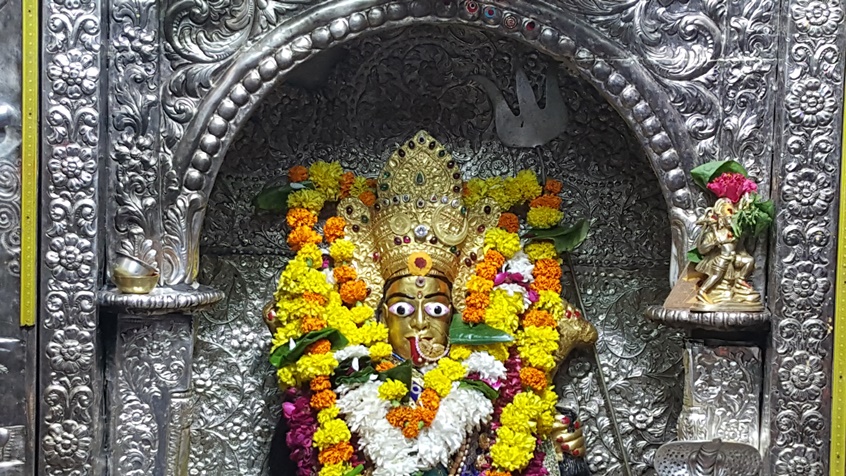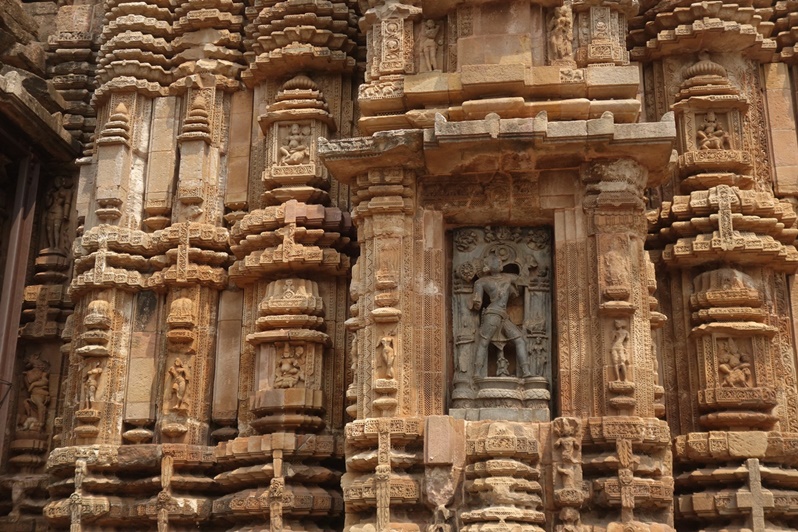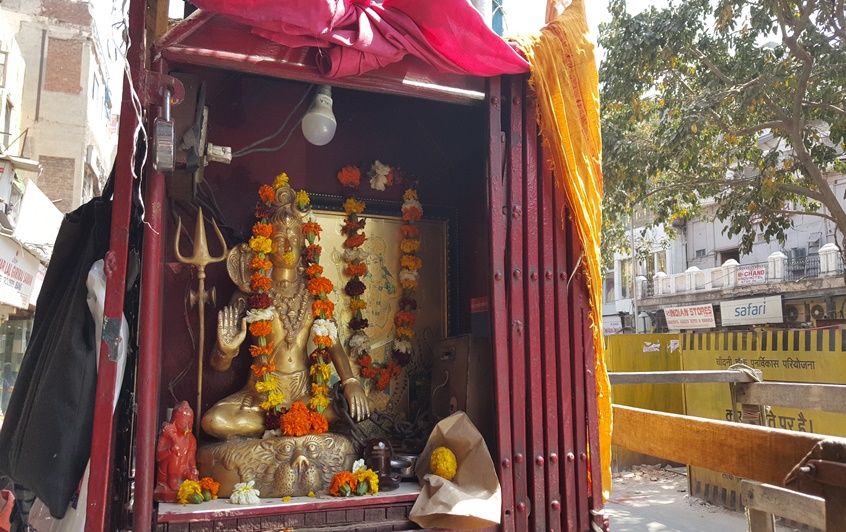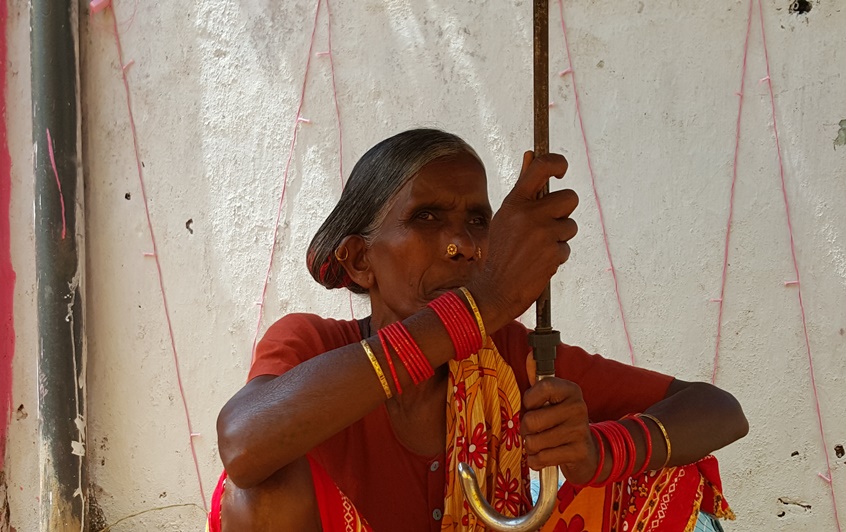
par Bertrand Bellaize, le 10 mars 2021
Hindouisme - divinité hindoue : la Trimurti – Parvati
La Trimurti est le socle de l’enseignement spirituel hindou qui permet d’expliciter le monde manifesté dans laquelle nous évoluons : Brahma représente le principe créateur, Vishnou, le préservateur et Shiva le destructeur qui permet le renouvellement. Ces trois forces sont indissociables, complémentaires et opposées.
Le Pudma Purana relate que pour conserver le monde qu’il avait crée, Brahma tira de son flanc droit Vishnou et pour pouvoir le détruire, il sortit de son flanc gauche Shiva.
Parvati, est une divinité complexe, tout comme l’est Shiva. Elle est à la fois bienveillante et terrifiante (sous la forme de Durga et Kali).
Elle est vénérée tout autant que Shiva, à la fois en tant que représentant l’absolu mais aussi sous la forme de l’énergie destructrice. Sa place dans le panthéon va bien au delà de son rôle de shakti (épouse, aspect féminin, énergie) de Shiva : si l’on évoque la Shakti, ou Dévi (déesse mére)seule, c’est alors de Parvati que l’on parle.
Bien souvent c’est l’union Shiva-Parvati qui est honorée : elle prend alors le nom de Ardhanarishvara, une forme unique androgyne, symbiose des deux divinités.
Les deux divinités sont en fait indissociable. Shiva incarne l’Absolu sous la forme non manifestée, la pure conscience tandis que Parvati personnifie l’Absolu matérialisé. D’un coté, l’aspect contemplatif (le Seigneur du Sommeil) et de l’autre l’aspect actif. Elle peut ainsi ainsi être considérée comme la Mère de l’univers (Devi), c’est grâce à son énergie (Shakti) que la pure conscience prend forme. En couple, ils sont nommés Umâmaheshvara.
Histoire de Parvati
Dans les mythes hindous de la création du monde, Shiva ne se préoccupait pas de trouver une épouse, il était absorbé dans son état de pure conscience, cependant Brahma savait la nécessité pour Shiva de se manifester afin que le monde qu’il avait crée puisse fonctionner harmonieusement, que le Dharma (l’ordre, l’équilibre) puisse s’accomplir. Avec Vishnou, ils le supplièrent, Shiva accepta mais à ses conditions « Proposez moi une femme aux traits avenants, experte dans la pratique du Yoga et capable de recevoir ma semence virile. Elle doit être une grande Yogini quand je m’adonne au Yoga et une amoureuse quand je me livre à l’amour « Shiva Purana.
Ainsi naquit Sati, fille de Daksha, un des fils de Brahma (un des Prajapati, pères de la création) qui conquit le coeur de Shiva. Cependant Daksha n’appréciait pas Shiva, dieu retiré du monde, vivant seul au milieu de bêtes sauvages, occupé par son ascèse et alors il ne l’invita pas lors d’un sacrifice important : Sati fût indignée et décida de s’autodétruire par le feu. Shiva, fou de douleur emportait partout le corps de Sati avec lui : ses gémissements, lamentations et pleurs (qui ont formés deux lacs à Pushkar et Ketaksha) emplissaient l’univers. Vishnou décida alors, à l’aide de son disque, de découper le corps de Sati qui retombèrent à 51 endroits sur terre : ces lieux sont aujourd’hui vénérés comme lieux de pèlerinage.
Dans le même temps, Brahma avait promis à Shiva que Sati renaîtrait sous une autre forme : ce fut Parvati, qui totalement éprise de Shiva, après une très longue ascèse, réussit à conquérir Shiva qui était retourné à sa vie d’ermite.
Le couple Shiva-Parvati représente en Inde (tout comme celui de Vishnu-Lakshmi) le couple idéal : le bonheur, l’amour conjugal, l’harmonie et la complicité sur tous les plans (intellectuel, sentimental et sexuel), la parité et la complémentarité.
Dans ce couple, chacun sacrifie une part de ce qu’il est, de lui même au moment du mariage mais grâce à cela, leur union enrichit chacun d’eux et les renforce dans leur vie quotidienne et dans leur quête spirituelle (ce qui est encore pour une large majorité des indiens le but de l’existence).
Ils symbolisent l’union des opposés, le Un : Shiva, l’état latent, Parvati, l’état dynamique qui permet la manifestation concrète. Symboliquement la forme du Lingam est très signifiante : le phallus est indissociablement lié au Yoni (la vulve).
Les prouesses sexuels de Shiva sont abondamment relatées dans certains textes hindous, mais l’important réside dans la possibilité de transcender la dualité dans la pratique de la relation sexuelle. C’est le sens profond du tantrisme où fondamentalement toute expérience est utilisée pour se rapprocher de l’Absolu. Shiva et Parvati sont tout à la fois amants et ascètes. Ils concilient la possibilité d’allier vie dans le monde (Bogha, jouissance dans le sens le plus noble et large soit l’appréciation de ce qui est, ici et maintenant) et Sadhana (recherche spirituelle).
Shiva peut aussi représenter l’intellect et Parvati l’éther ou alors la destruction et la douceur, le froid et le chaud, le sommeil, la création.
Ainsi sans Parvati pas de manifestation, le monde resterait à l’étant latent, sans forme, pur Absolu, immuable (Shiva). Ils peuvent alors être nommés Prakiti (la matière cosmique) et Purusha (l’esprit cosmique).
Parvati la montagnarde
Adorée seule, elle incarne le pole féminin de l’Absolu.
Réincarnation de Sati, Parvati est représentée comme une belle femme, aux formes généreuses. Elle est parée de nombreux bijoux : bracelets, colliers, boucles d’oreilles, couronne…. Sa peau dorée ne l’a pas toujours été. Alors que Shiva la taquinait sur sa peau noire, Parvati se mit en colère et commença une longue période d’ascèse : Brahma touché par sa dévotion lui offrit une peau d’or. Elle incarne la beauté féminine, l’intelligence, la sensualité, l’amante accomplie et la mère.
Son front est orné du Bindu, point rouge symbolisant la plus petite forme manifestée d’où jaillit et se déploie l’énergie marquant ainsi sa capacité créatrice (les femmes indiennes le portent ainsi quotidiennement)
Elle a souvent quatre bras, deux peuvent tenir un lotus (rouge ou bleu) tandis que les deux autres font le geste de don et de bénédiction. Elle peut porter un miroir (Darpana souligne le vide : le miroir est un témoin neutre, il reflète tout mais ne s'identifie à rien. Sa neutralité est totale : il ne juge pas, ne compare pas, ne dénigre pas et ne saisit pas ce qui lui est présenté : c'est un formidable symbole de la pure conscience. Il peut aussi exprimer, plus concrètement, l'attachement à ce qui est irréel, à savoir le reflet, la surface des choses (qui est donc illusoire (Maya) dans le sens où ce n'est qu'une réalité apparente tel un mirage): le manifesté par opposition à l'absolu qui est l'essence de la réalité).
Elle peut être accompagnée d’un pot de terre surmonté d’une noix de coco qui figurent son aspect nourricier.
Sa monture est le lion. Il est bien évidemment symbole de puissance, de force, de souveraineté et donc de protection (justice) : il est ainsi présent sur le blason de l’Inde.
Annapûrna, forme de Parvati qui insiste sur sa fonction nourricière, sa générosité. La mère qui nourrit, elle est ainsi la divinité protectrice de Varanasi.
Gauri, la blanche, forme de Parvati qui met en avant la beauté, la grâce, l’épouse heureuse et accomplie, la plénitude. Les femmes indiennes la vénèrent beaucoup, c’est un modèle à la fois en tant que femme et épouse mais aussi à travers le couple qu’elle forme avec Shiva. De nombreuses fêtes lui sont consacrées (Gauri Vrata, la fête de Teej, Gangaur…).
Durga Mahishasuramardini : la tueuse du démon buffle
Durga est une des formes prises par Parvati sous sa forme destructrice. Durga exprime une terrible force sereine : elle symbolise la victoire de la connaissance sur l’obscurantisme mais aussi la puissance. Son aspect bienveillant est cependant présent car elle est aussi la mère protectrice, généreuse (elle vient au secours des plus faibles), celle qui rétablit l’ordre du monde : elle peut être alors appelée Aparâjitâ, l’invincible..
En des temps immémoriaux, Mahishasura, le démon buffle, grâce à de nombreuses austérités, gagna une grande force et Brahma lui accorda, non l'immortalité mais le privilège de ne pouvoir être tué que par une femme. Vaniteux et devenu un géant invincible, Mahishasura combattit et vainquit les Dieux qui durent faire appel à Brahma, Shiva et Vishnou : de leur colère émergea Durga, d'une beauté parfaite et dotée de toutes les pouvoirs personnifiés par ses nombreux bras et armes fournis par les dieux. Aidée de Kali, elle terrassa facilement l'armée de Mahishasura et lui trancha la tête après un combat épique.
Durga est souvent représentée avec huit bras dotés de 8 armes fournies par les dieux :
La conque (le son primordial) donnée par Vayu, dieu du Vent ; la masse (la force) donné par Vishakarman, l'artisan des dieux ; le rosaire (la connaissance) donné par Brahma ; la roue ou disque (le soleil, la lumière) donnée par Vishnou ; la lance (la puissance) donné par Kumara, le dieu de la guerre, seigneur des armées divines ; le sabre donné par Yama, seigneur de la mort ; le trident fourni par Shiva ainsi que le damaru, le lotus...
Les armes, nombreuses et diverses, indiquent que pour triompher d'une menace ultime, il faut allier de nombreuses qualités à la fois physiques (force,...) mais aussi spirituelles.
Kali, la noire
Kali est une forme de Durga. Kali détruit, elle exprime la rage, les terreurs primitives, elle est souvent représentée sous une forme terrifiante, pleine de sang, échevelée, dansant nue sur les cadavres - mais c'est aussi la force ultime qui permet de vaincre, dépasser les peurs les plus profondes, les plus archaïques.
Dans le Devimâhâtmya, Kali naît du courroux de Durga : elle jaillit de son front : hurlante de rage dès sa naissance, elle est noire, prête à délivrer le monde des démons. Kali est l'ultime recours : dans la mythologie hindoue, elle aide les dieux impuissants. Dans la bataille contre Shamba et Nishumbha, Kali enivrée par le sang des démons se mit à danser tant et tant que les vibrations menacèrent l'existence même de l'univers. Shiva se jeta à ses pieds pour le sauver en amortissant cette terrible force. Elle alors nommée Chamunda.
Kali signifie noire mais c’est aussi le féminin de kâla, le temps : c’est le maître du temps (Mahakali), l’équivalent de Mahakala, Shiva.
Sous cette forme terrifiante, l’hindouisme nous rappelle qu’en nous se côtoient la bienveillance tout autant que la violence, la lumière tout autant que la noirceur : il s’agit de Voir (dans le sens de connaître) et de se lancer à l’assaut de nos démons intérieurs, de notre mental, mais aussi de puiser dans nos forces primordiales pour vaincre nos terreurs. Il n’est pas possible d’atteindre la libération sans un combat acharné, épique : ce qui est détruit n’est pas la vie mais les illusions qui nous maintiennent dans la prison de l’identification à l’égo. Alors se dévoile l’aspect compatissant de Kali !
Sources
Sarah Combe - Un et Multiple – Editions Dervy
Alain Daniélou : Mythes et Dieux de l’Inde


